Immersed in Mansions of Madness 2nd Edition
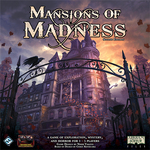
The line between physical board games and digital board games is blurring more and more every day. A ton of physical board games have gone digital over the last few years to great success. Players can choose whether to play the physical version or the digital version depending on where they are or who they’re with.
Well, Mansions of Madness 2nd Edition has shattered this divide!
It’s no longer “either/or” – now it’s completely both. That’s because the digital Mansions of Madness app is the only way to play the physical game. You can’t play one without the other.
And it’s wonderful!
In Mansions of Madness 2nd Edition, players interact with both the physical game components as well as the digital app. Players use boards, cards, tokens, miniatures, and dice while the app unfolds the story before them.
It’s truly an immersive experience that pulls us in and keeps us wanting more.
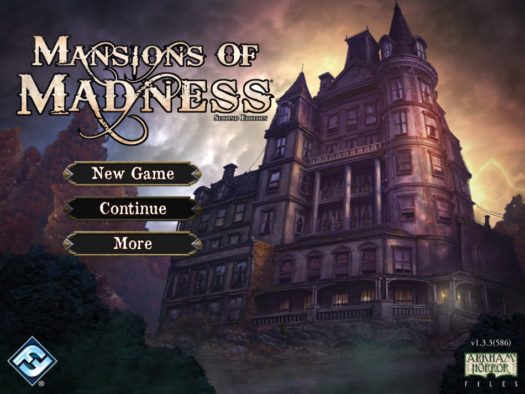
How to play Mansions of Madness 2nd Edition
I could keep this section really short and just say, “do what the app says to do”. But that would be over simplifying it all.
Yet, at the same time the app really is the driver of all the action in the game. And it’s very cool!
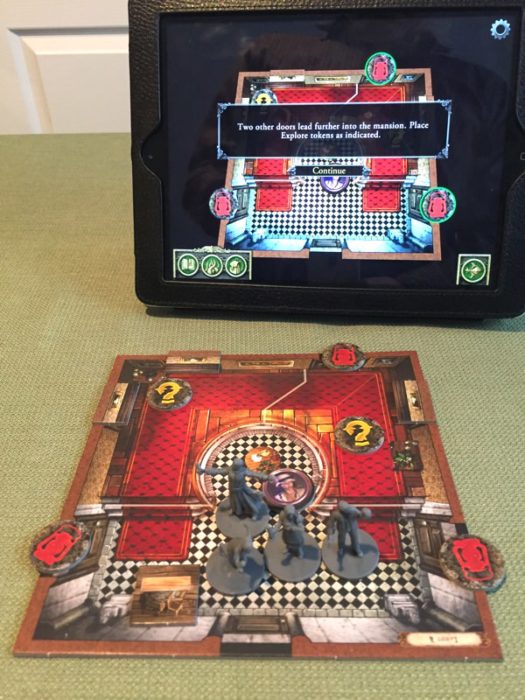
Of course there’s more to it than that because like many Fantasy Flight games, the game comes with 2 rulebooks. There’s a 19-page “Learn to Play” book and a 24-page “Rules Reference” book. So you know there’s plenty to discover.
I’ll just give you a quick taste of the flow of play and spend the bulk of this review in sharing our thoughts.
The rulebook does a great job of describing the set up complete with diagram of what’s what.
There are three essential choices when setting up the game – players choosing their characters, their starting possession, and which scenario to play. Since it’s a cooperative game, players freely discuss choices during set up as well as during play.
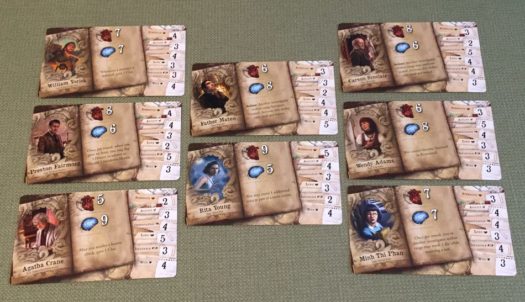
Game Turns
Mansions of Madness is played over many game rounds. There are 2 phases to each round: Investigator Phase and Mythos Phase.
During the Investigators Phase players can choose their turn order and each investigator (player) can take 2 actions. They can do the same action twice or choose two different actions: Move, Explore, Search, Trade, Interact, Use Component Action, or Attack.
Many of the actions require the player to interact with the game app. For example, to Explore an adjacent room the player taps the Explore token corresponding to the area he wants to explore. The app then reveals which board tile to place and any special tokens or monsters that go in the spaces on the new tile.
Similarly, to Search in an area, the player taps on the token icon in the app and the app describes what happens next.
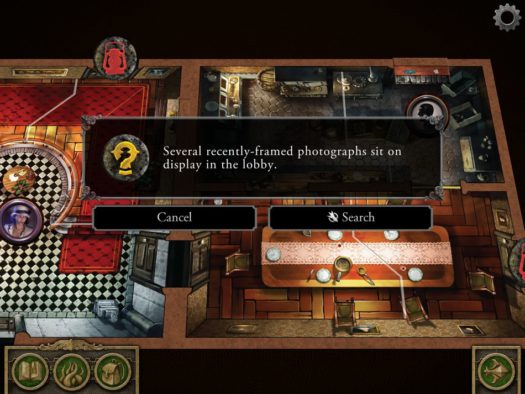
The Attack action requires players to select the monster they’re fighting from the “monster drawer” section of the app. The app keeps track of which monsters are in play to make it easy for players to choose the one they’re going to fight. Once the monster is selected, the app asks what type of weapon the investigator wants to attack with.
Then the app will describe what’s happening in the fight and what dice results the investigator will have to roll to succeed. Since the game is very story driven, it also describes what will happen to the investigator if they fail the die roll.
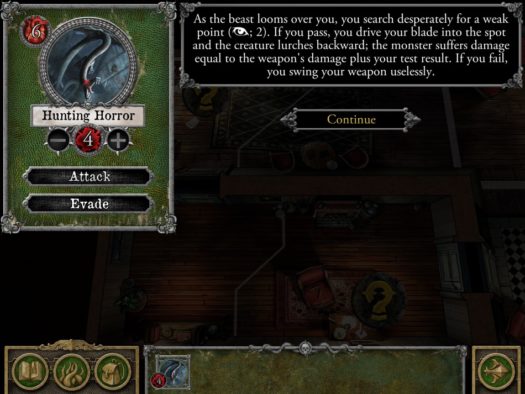
Once all investigators have taken their turn, a player indicates that phase is over by tapping on the icon in the app and the Mythos phase begins.
During the Mythos phase the app generates a number of game effects that the players will have to react to.
First are Mythos Events. These events may be related to the scenario or to actions the investigators have taken.
Second are Monster Activations. Each monster currently on the board will activate and the app indicates the order and actions those monsters take. Inevitably, these monsters will also attack investigators!
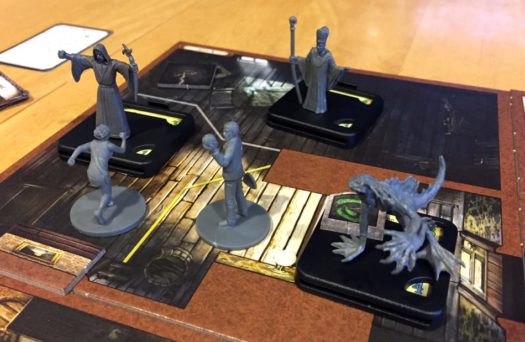
After a monster moves, the app will ask if the conditions are met in which it will attack one or more investigators. If so, players select “monster attacks” and the app again describes the fight and what the investigator will need to roll to succeed/survive.
The third step in the Mythos Phase is the Horror Checks. Each investigator will have to resolve a horror check against the monster in range with the highest horror rating (all explained in the well-organized rulebook).
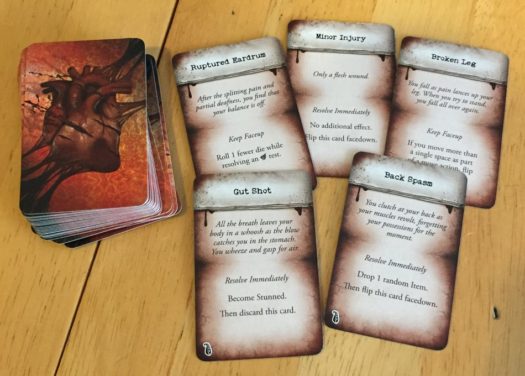
Game End
At the outset of each scenario, the investigators won’t know what their objective is to win the game.
As they explore and interact with the unfolding events of the scenario, they’ll discover what they need to do in order to win.
If the investigators complete their investigation successfully, they win!
If they take too long to complete the investigation, the objective may change or become more difficult. And if they continue taking too long, they’ll lose.
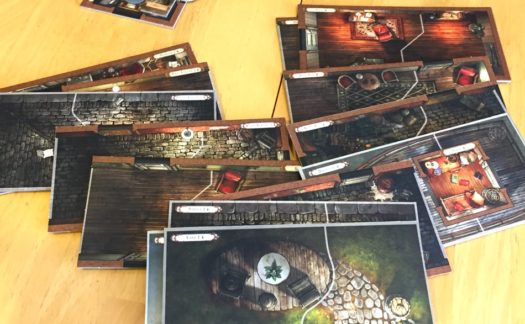
Additional Rules
The basic flow of the game I just described merely scratches the surface of the game. There’s so much packed into this game!
Since it’s an adventure game, you’re correct in thinking there are plenty of situational aspects of the game that require more specifics in the rules.
For example, each character has unique statistics for their attributes (Health, Sanity, Strength, Agility, Observation, Lore, Influence, and Will).
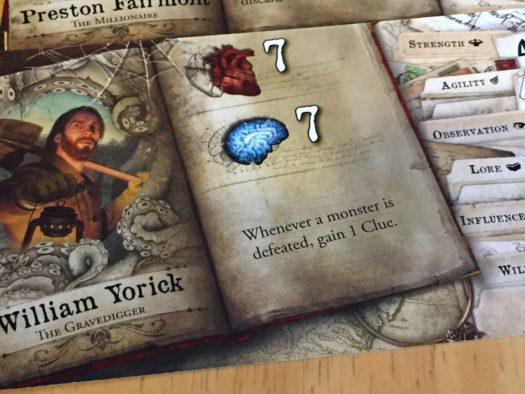
Players can also take Damage and suffer Horror. They can also go insane!
And when they go insane, they draw a card that may or may not change their personal objective in the game – which may conflict with wanting the investigators to win.
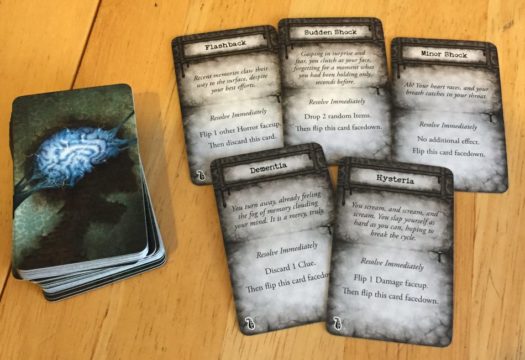
There are also plenty of rules to know about the monsters, items, spells, and other conditions.
If that weren’t enough, the game also includes various puzzles players encounter during they game that they must solve using the app.
Needless to say, diving into Mansions of Madness is quite an experience.
Can the whole family enjoy playing Mansions of Madness 2nd Edition?
Mansions of Madness 2nd Edition isn’t a game everyone in the family will enjoy playing. And there are a few reasons why.
First of all, the games are long. The shortest game we’ve played has been an hour and a half. Even though the introductory scenario may be listed at just 60 minutes, because it’s a first game, you’ll spend a lot of time consulting rules to make sure you’re playing correctly. After that, we want to play the rest of the scenarios, which are even longer.
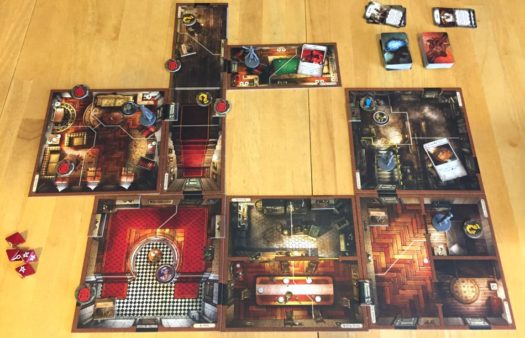
The length of the game is also tied to the next reason why some might not enjoy playing the game – there’s a lot going on. You can tell by the size of the box that there’s a lot packed into the game. And some people will be completely turned off by the amount of components in the game.
The other reason some might not enjoy the game is because of the theme. The scenarios in Mansions of Madness are inspired by the works of H.P. Lovecraft. Those who are turned off by the theme, won’t give it a second glance. Yet while we’re not Lovecraft fans, some of us have still enjoyed the game. (“Some” being the boys.)
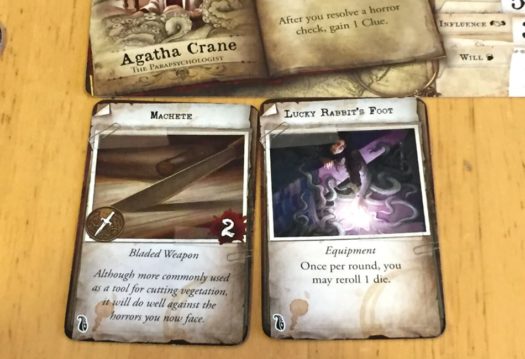
The recommended age of 14+ is most likely a combined effect from the above reasons.
Yet if you’ve read this far in our review, my guess is you’re not turned off by any of those reasons I just mentioned. So read on and see why I’ve really enjoyed playing Mansions of Madness 2nd Edition.
What I love about Mansions of Madness 2nd Edition
I’ve already mentioned that I’m not an H.P. Lovecraft fan. I’m also not a fan of dark stories and horror movies. And I never played the first edition of Mansions of Madness.
So why have I enjoyed this game?
Well, there are a number of reasons.
The first reason is because of how immersive the game is. It takes a while to read through the rules and get familiar with all the components. It takes a while to put the miniatures together with all their bases. And each game lasts a long time. Yet after each game, it never felt like it had lasted as long as it had. That’s because we were totally caught up in the immersive game experience.
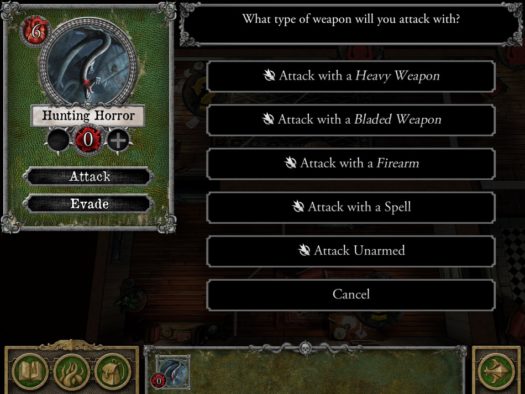
Each scenario is a mystery to be solved. And I love that puzzle-like nature of the game. As players, we work together to explore the various locations and search for clues to even figure out what’s going on in the scenario. Once we uncover the mystery, it’s a race to complete the investigation.
And during all of that we’re making choices along the way of how to spend our measly 2 actions. The great thing about only having 2 actions per investigator is that turns go by relatively quickly. We don’t feel like we’re sitting around waiting for our next turn. Instead we’re paying attention on everyone’s turn and chiming in with our thoughts about which actions they should take as well.
The competitive sleuthing is a lot of fun.
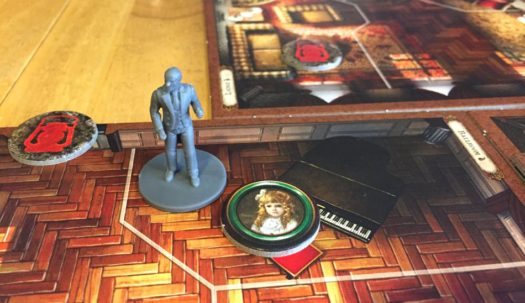
I also love that during each Investigator round we can choose in which order to take our turns. It’s not the same every round. It’s not based on any arbitrary initiative number of our character or anything like that. It’s completely up to us on the best way to proceed by who goes first and what they might uncover.
When the Mythos phase comes around, we anxiously anticipate what bad things will befall us. We know something bad will happen and we just hope it’s not too bad.
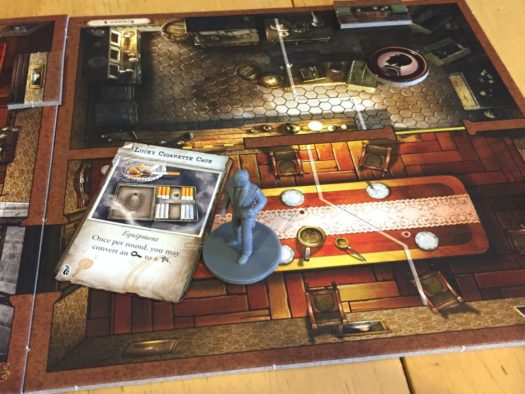
And of course, I love the app integration!
In and of itself it could be just a gimmick. But in Mansions of Madness 2nd Edition, it’s not.
The app is a big reason the game is so engaging.
Every time you attack a monster (or a monster attacks you) things may play out differently. Players can’t get comfortable thinking they know what they’re up against. Because the battle description will change based on a number of factors and the results needed to succeed on the dice rolls will differ.
The app is also so smooth to work with.
Want to Explore the adjacent room? Just tap the icon in the app.
Want to see what item was left in the room? Just tap on the Search icon in the app.
Yet, the results of attacks still depend on physical dice rolls!
I love that the app doesn’t try to do dice rolls for you. First of all, because rolling physical dice is much more fun than tapping a dice roll button. And second, because no one trusts the results of digital dice rolls anyway.
Players roll the dice during attacks and then just tap on the “+” symbol next to the monster image in the app to show the damage to the monster. Once the monster has reached its health, it’s destroyed. And the app knows.
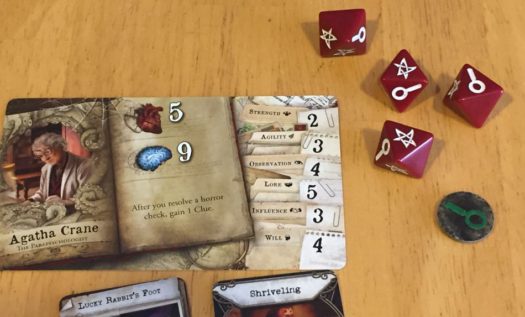
The app knows everything. It builds out the scenario, keeps track of the active monsters and items collected, and much more.
Each player will get to interact with the app on their turn. But this also has a downside. Because when one player is holding the digital device, the other players won’t be able to see what’s going on unless they crowd around each other. Sure, the active player can read everything out loud, but we know everyone wants to see what’s going on.
So what we’ve done is broadcast it onto our TV!
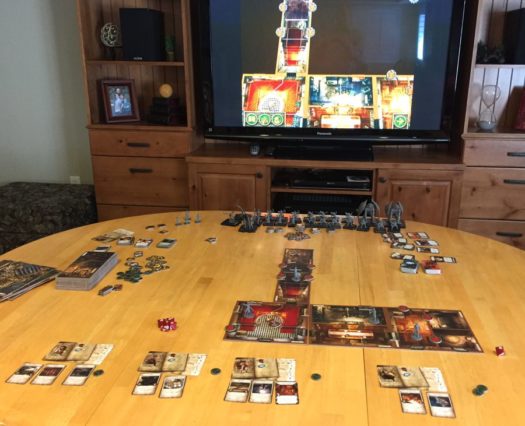
This way we can still pass the iPad around the table for players to interact with it themselves on their turn and everyone can see what’s on screen at the same time!
We scoot the table up close to the TV and sit around the other sides of the table to play. The added benefit is that seeing the scenario unfold on a TV makes the game feel even more immersive to play.
Mansions of Madness 2nd Edition gets 2 big thumbs up from me!
Things I don’t like about the game
Fantasy Flight Games makes awesome board games. They create fantastic game experiences with cool components that draw you in.
That’s why we were so surprised to see the monster miniatures in Mansions of Madness 2nd Edition come up short.
It’s not that the models are bad. We quite like the look of the various monsters.
But the bases for the miniatures stink!
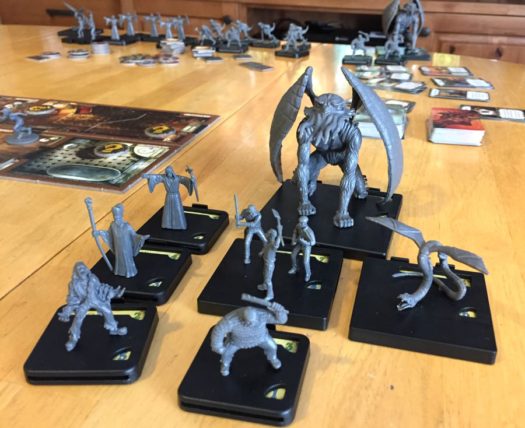
Each monster has to be placed on a square plastic base before playing. The bottom of each miniature has a nob that sticks into the plastic base. Additionally each monster has an identifier cardboard token that slides into the base. The bases have two corners where number values for the monster can be seen (or at least are supposed to be seen). And the bottom of the base is open so players can read text on the bottom of the token slid into the base.
However, we found these bases absolutely useless!
Not only do the monsters fall out of their bases frequently, the numbers are also still hard to see.
Why can’t the monsters simply be standard miniatures with reference cards?
That’s the way it is in Descent and other FFG games we love. And we don’t know why it couldn’t be the same case here.
It bugs me so much I’m going to cut off the nob on the bottom of each miniature and glue them to standard miniature bases. Then we can play as normal and set the monster descriptive tokens next to the board as a reference when they’re active.
The other thing I haven’t liked is the limited number of scenarios available to play without needing to buy an expansion.
I know it’s inevitable there would be expansions and that they’d be tied to the game app as well. But I thought we’d be able to go through more scenarios with just the base game before that happened. Instead, when choosing scenarios to play, many aren’t really an option because they require a physical expansion to play.
Sure it’s nice to know there’s plenty more to play in the future. But it also tells me right away that I better start budgeting for more games…
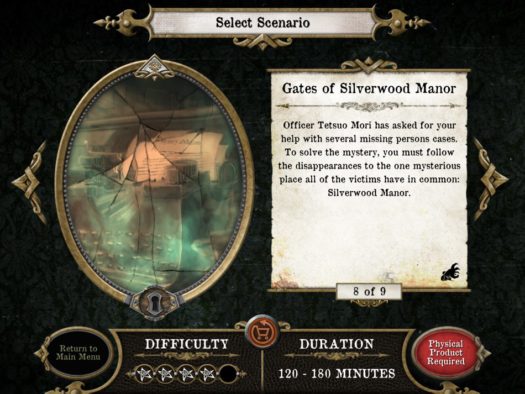
Bring more Mansions of Madness along
The good news for those with the first edition of Mansions of Madness is that the second edition also comes with a conversion kit. It incorporates investigators, monsters, and map tiles from the first edition into the new game.
For those not familiar, the first edition was a semi-cooperative game where one person controlled the Mthos phase and the rest were the investigators. The downside was that if that one person made a mistake, it could ruin the whole game. Now with the app, it’s a fully cooperative game and the app won’t mess up.
Since we don’t have the first edition, we don’t have the figures for the investigators or the monsters. But this conversion kit comes with a bunch of investigator cards and monster tokens. So we can simply use stand-in miniatures and still play with characters from the first edition.
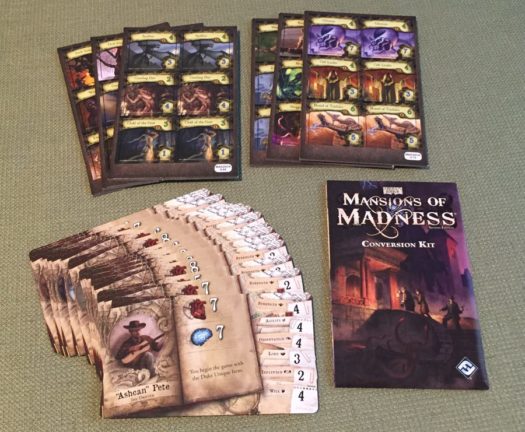
How does Mansions of Madness 2nd Edition score on our “Let’s Play Again” game meter?
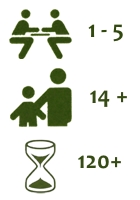 Since Mansions of Madness 2nd Edition is a relatively long game to play and requires the right group of players to dive in, I don’t imagine playing it super often. But that doesn’t mean we don’t want to call out, “let’s play again”. Because that’s exactly what happens as soon as finish a game.
Since Mansions of Madness 2nd Edition is a relatively long game to play and requires the right group of players to dive in, I don’t imagine playing it super often. But that doesn’t mean we don’t want to call out, “let’s play again”. Because that’s exactly what happens as soon as finish a game.
We totally want to dive into another scenario. So instead, we pull out our calendars and look to the future when we can dedicate another night to a Mansions of Madness investigative experience.
Speaking of which, I think one of those nights is coming along rather soon…
We’d like to thank Miniature Market for a review copy of Mansions of Madness 2nd Edition.

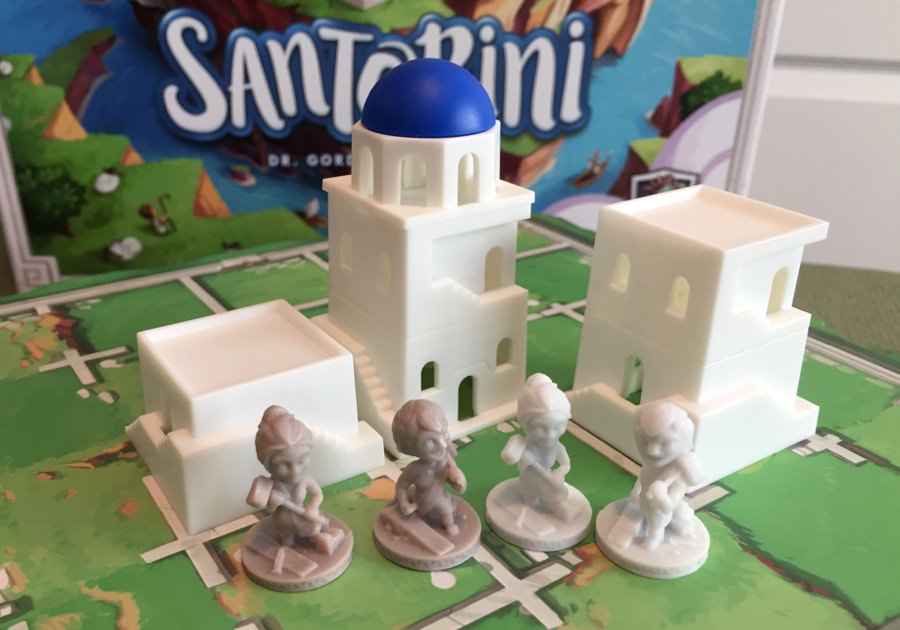

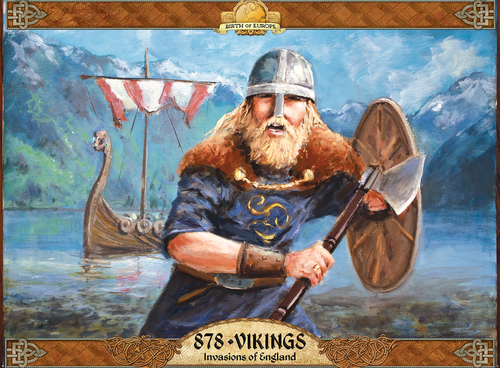
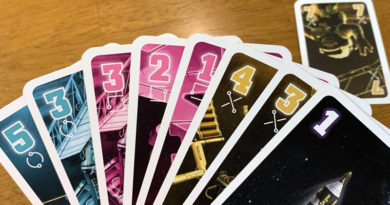
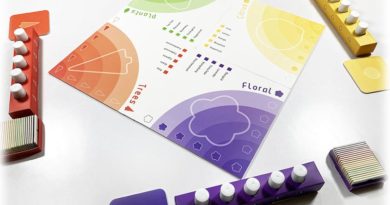
Nice review. I’d like to know how you were able to project iPad to your tv?
Michael – We have an Apple TV device that lets us mirror the screen from an Apple device to another screen. It’s very cool.